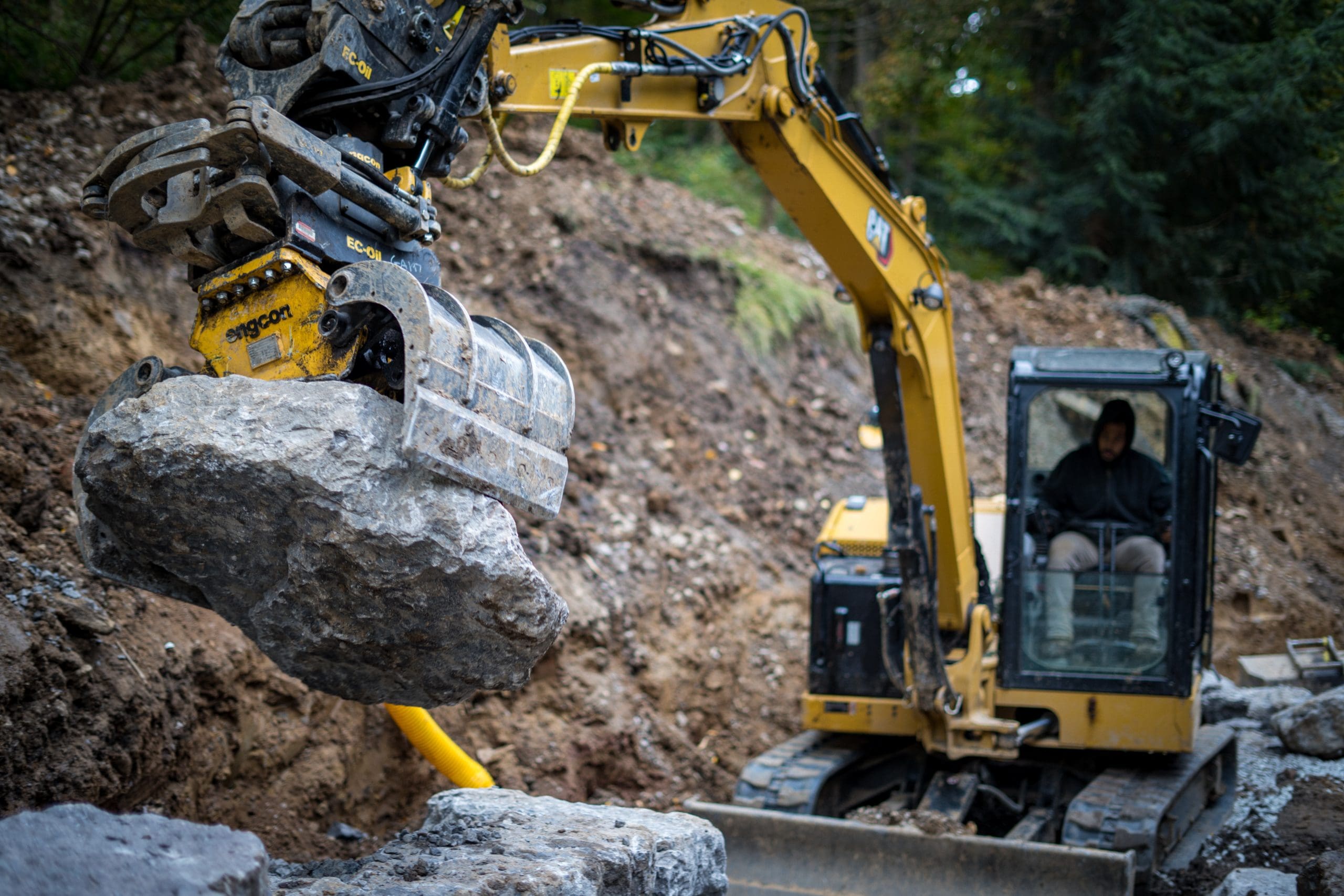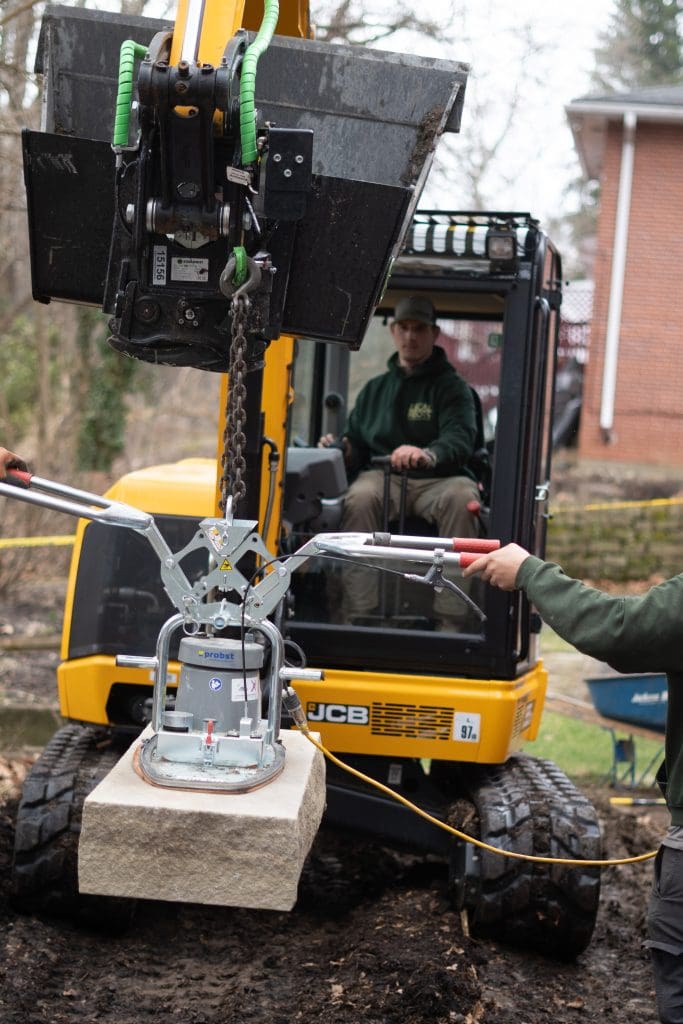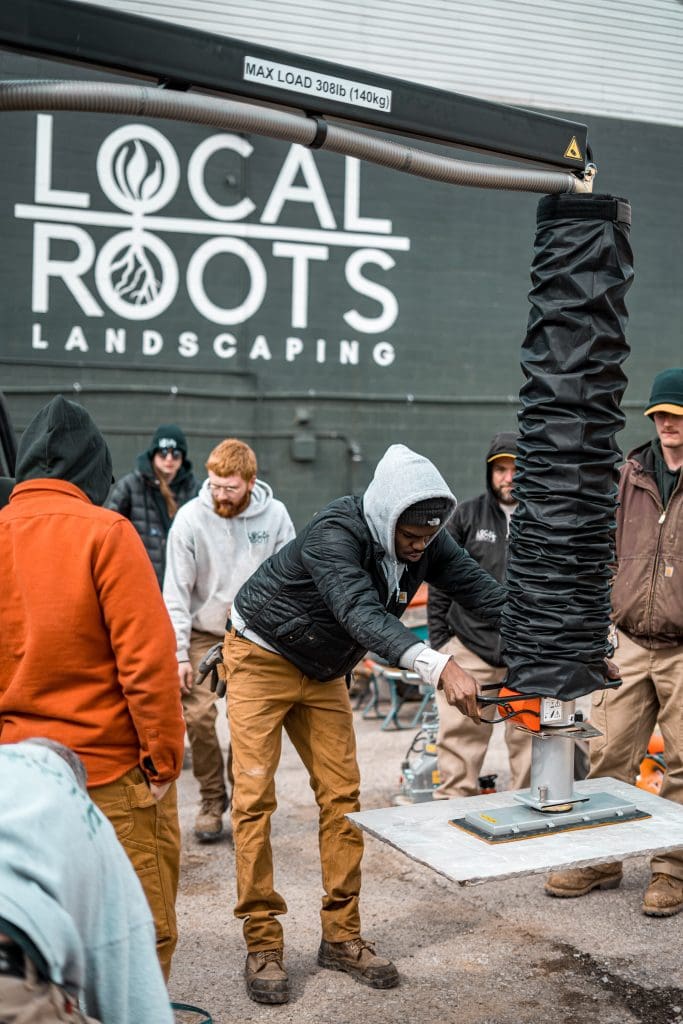
Photo: Local Roots Landscaping
With labor being a constant challenge in the landscape industry, taking advantage of various equipment innovations can help you make the most of your current workforce and boost morale.
Local Roots Landscaping, based in Pittsburgh, Pennsylvania, started seeking equipment that could increase their efficiency after buying a wheel loader in 2019. Patrick Murray, managing partner of Local Roots, says the machine cost $120,000 and in one year, they were able to save three times the labor cost.
“That got our brains thinking if this basically saves a salary in a year, it’s worth the purchase and especially because it’s a loan purchase, so you’re not seeing the realized costs of $100,000 upfront,” Murray says. “Essentially, we are always hiring and growing, but our goal is to replace the hardest labor and the most menial labor with machinery.”
Murray says if they can replace a very grueling position with a piece of machinery and the cost is the same as the cost of labor, it’s worth it to them to purchase. He adds that using equipment that improves efficiency also can make employees’ lives better where they enjoy coming to work.
What to Consider
In the beginning, Murray says he and fellow managing partner Kenneth Deemer would simply see new technology and decide to try it out. This didn’t work the best for them as they weren’t getting input from the team.
Two years later, they implemented a leadership team and Murray says he wishes he had formed the team sooner as it gives their leaders more agency in decision-making.

“As owners, it’s always so hard to give up that control, but as soon as you do it, you realize we should have done it years ago,” Murray says. “The control was ‘we know what our company needs best in all ways, ’ but as you lose touch with the field staff, why do I think that I know what’s best for them?”
Now with the leadership team, they’ll analyze the jobs they’ve done, including the size of the jobs, access to the job sites, what worked well for the crews and what didn’t, as well as general team feedback. All of this is taken into consideration with their efficiencies. Local Roots’ director of operations will put together a proposal of what equipment he thinks they should buy for the upcoming season.
Murray says they have a refining process where they push back a bit until they reach a resolution on how much to spend. He says with their debt-to-equity ratio, Murray says 2 is their cap. He says they don’t like to go over that number because they don’t want be overleveraged.
Local Roots typically demos new equipment from their vendor for a few days. Murray says this allows them to save money and they can quickly tell if a machine is not a good fit for them.
Deemer does all the research on the new equipment innovations and what he’s seeing out in the industry. They will track how many hours they spend doing a certain task and decide if adding a new piece of equipment can cut those hours down.
Murray is very serious about making sure the yard is empty of equipment and it’s not just sitting on trailers because if it’s not being used it’s a waste of an investment. They look for equipment that they can utilize on 100 percent of their jobs.
Recent Equipment Additions
Some of the equipment Local Roots has added include tiltrotators and a Unilyft (a paver laying assist machine). The company started using tiltrotators three years ago. Murray says one of the main benefits of the tiltrotator is the flexibility when working with natural stone and boulder walls. The attachment allows the excavator claw to rotate like a wrist. He says they don’t have to have another worker near the excavator staging materials when using a tiltrotator.
“It’s very much a one-person job in a lot of ways,” Murray says. “You can have your other workers doing other things on site, while the builder is just placing the exact materials that he wants on that wall.”
Currently, they have three tiltrotators and six install crews sharing them. The question for next year is if it makes sense to purchase another one to three more tiltrotators.

With the Unilyft, Murray says they first demoed it at Hardscape North America and fell in love with it.
“We could never quite justify the expense of it until we started selling more large format pavers and patios,” Murray says. “Our team all wanted it, but we were laying a lot of small format pavers.”
He says with their JCB teleskid they can use the Unilyft unit to lay pavers on top of large walls. Murray says one of the main benefits of the Unilyft has been the ability to go from three-person to two-person crews. A more intangible benefit is how excited his employees are when they return to the shop after installing a patio with the Unilyft. He says they are excited by being able to work efficiently and eliminate a taxing aspect of the job.
“We’re seeing a large range of people saying, ‘I’m just so thankful that I can feel proud of my work, and I can actually feel very refreshed after work doing it,’” Murray says.
Advice for Others
A major aspect of equipment implementation is employee buy-in. Murray says you can’t neglect training and familiarization if you want your teams to use new tools.
“Just because you buy it, doesn’t mean people are going to use it and love it right off the bat,” Murray says. “The first step is getting it and doing the research on it but then it is true implementation and training and then persistence with that.”
Murray admits that before they gave the team agency, they typically weren’t super excited about the new equipment. He says now when they can see the things they spoke about coming into existence, they light up, seeing the equipment delivered to the shop. He says they take ownership and are hungry to be trained on the new equipment.

Local Roots starts the year out with a week of training sessions on all thing machinery and safety-related. They had a multiple-hour class where they trained on the tiltrotator so they could get a feel for who was a natural and who needed some more time practicing. The learning curve for each employee can vary.
“We add what we call training hours on to the job,” Murray says. “He deserves a little bit of cushion here because we’re actually asking him to perform and do something that he’s actually not very good at yet. We want him to have the courage to do that. So we will inflate hours and we’ll tell them, ‘Hey, we’re adding hours on’ and that gives them a sense of confidence as they’re not stressed to beat their hours and then they make a mistake.”
Murray also suggests pushing to failure when utilizing your new equipment. Their crews were reluctant at first to go to two-person crews, but he wanted to see how it would work.
“The two-person teams now they have the best of the best equipment, so they have the tiltrotators, they have the vacuum lift, they have everything that basically would replace our least skilled labor,” Murray says.
He encourages smaller business owners not to be intimidated and to invest in innovative pieces of equipment earlier on.
“They’ve wasted so much time and so much potential just because they didn’t understand what they were capable of doing with this equipment,” Murray says.
Murray says you can’t get sticker shock with the prices of the machines because it’ll overwhelm you. Instead, you need to analyze what you’re already spending. He argues that labor waste is unbelievable, but it’s easier to stomach because you don’t see it all at once. Conduct a simple cost-benefit analysis on how much you’re spending on labor and, if you buy a piece of equipment, how much you’d spend a month instead.

